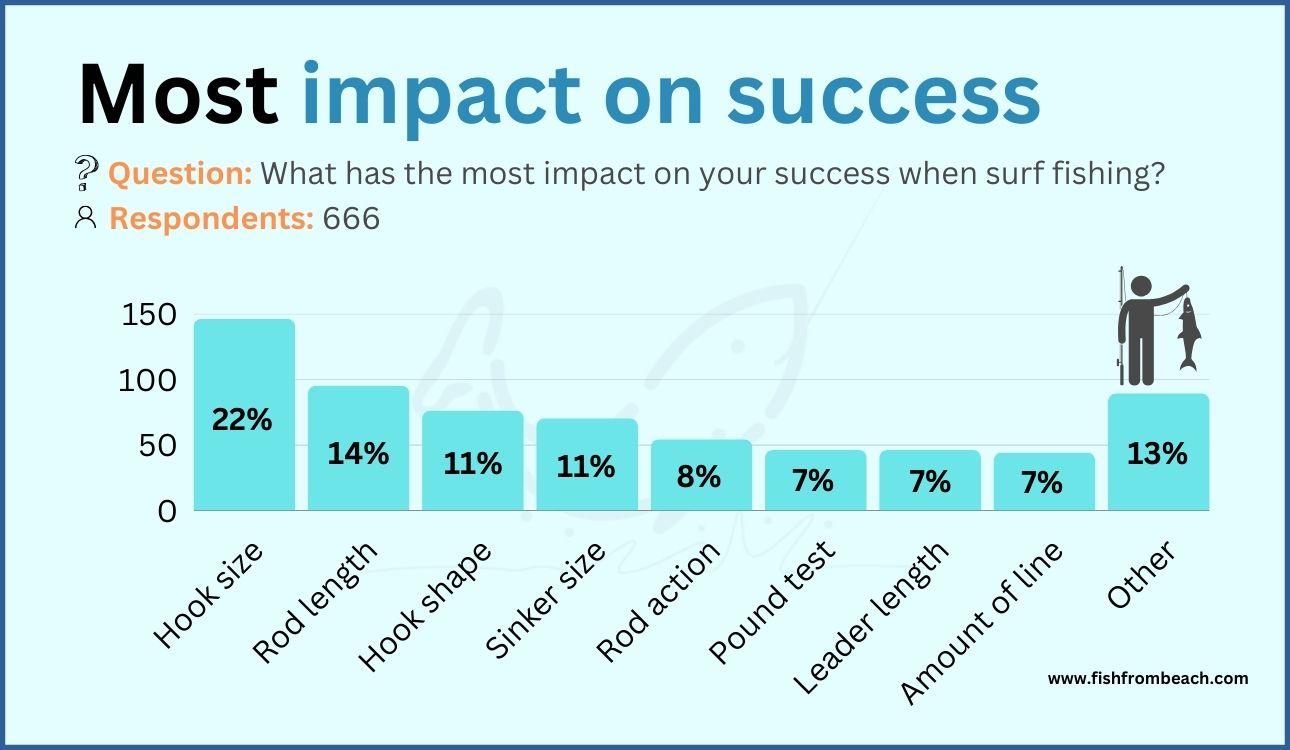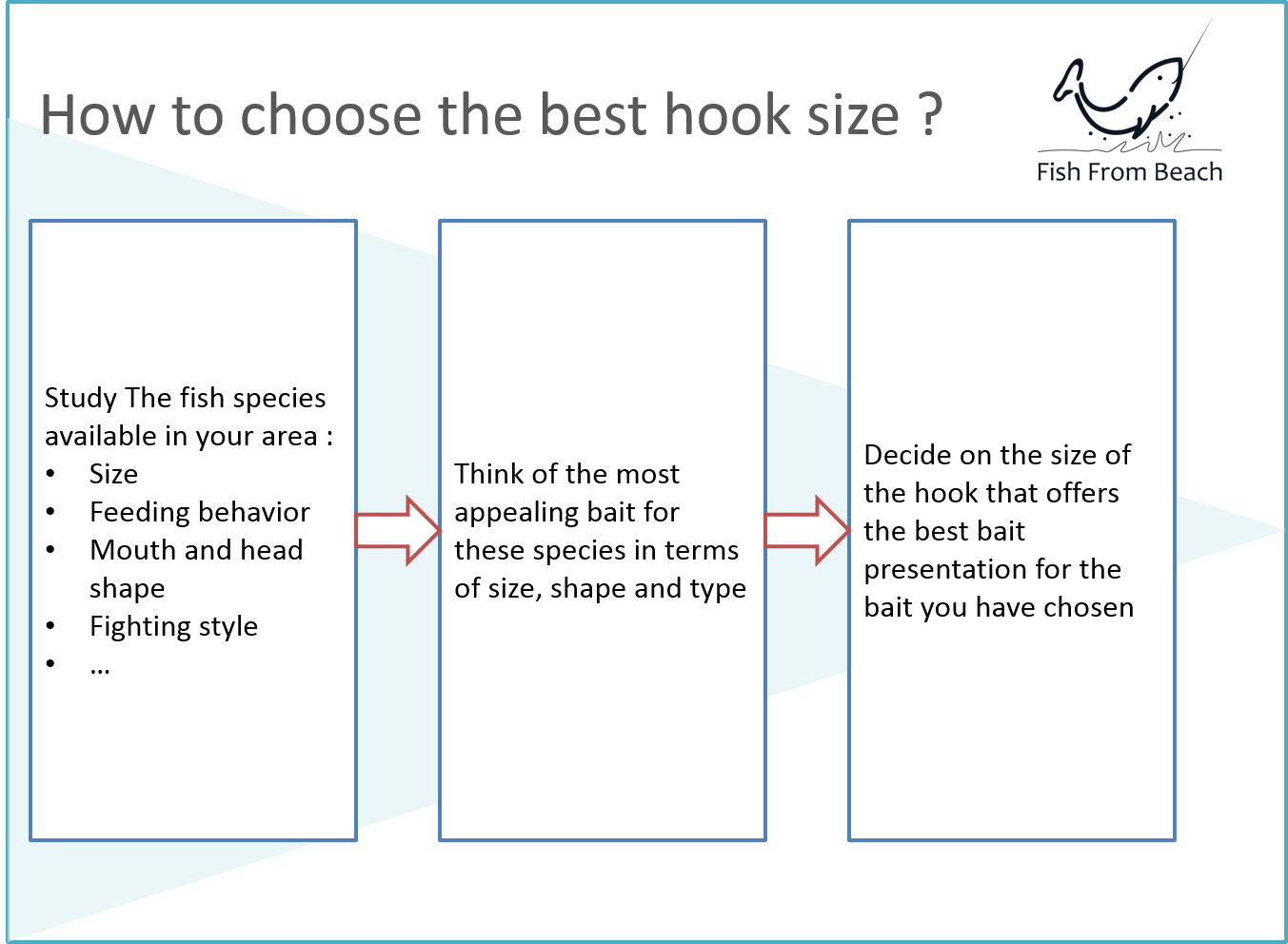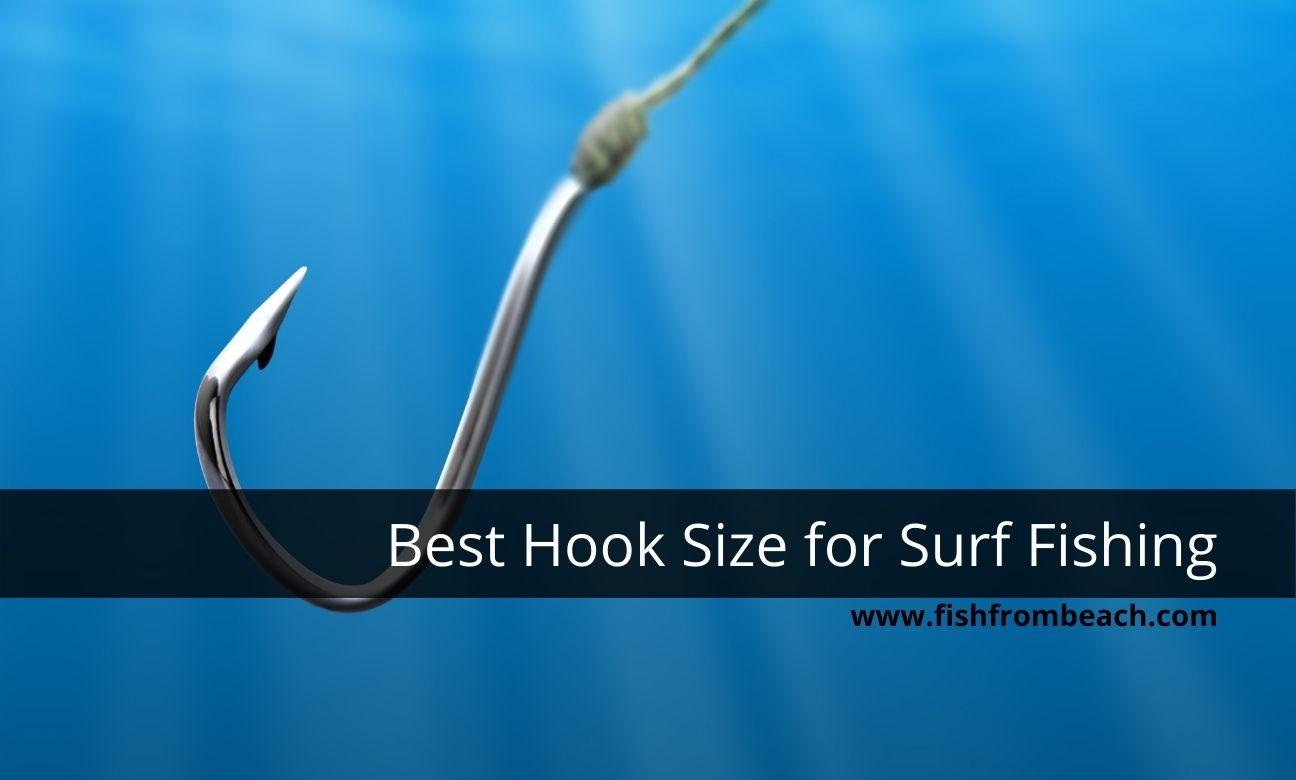In our survey about surf fishing, most anglers (22% out of 666 votes) said that the size of the hook has the biggest impact on their surf fishing success.

In this article, we’ll discuss all the factors to consider when picking a hook size for surf fishing. So without delay, let’s get started!
Small hooks tend to work better for surf fishing. In general, hooks ranging from size #2 and 3/0 cover most surf fishing scenarios and prove to be effective with various species we catch in the surf.

The most important rule to remember
You will lose more catches because of a poor bait presentation than you will ever do because of a hook that is too large or too small.
I want you to read the previous sentence one more time and remember whenever you think about the right hook size to use.
Let me say it in other words.
If your bait presentation is good and tempting for the fish, you will have a lot of catches even if the hook is too small or too big for the species you chasing.
On the flip side, if your bait presentation is poor, your catch score will suffer even if you spend hours rationalizing your choice.
So that’s the most important rule to remember.
Never base your choice of hook size on the fish you want to catch. Instead, only think about the bait you plan to use.
Simply put, you want your hook to ensure a good bait presentation. And by good bait presentation I mean 3 simple things :
- The bait is holding securely on the hook and will not dislog or crumble easily after the cast
- It’s appetizing for the fish and looks like natural food for them
- It’s difficult for the fish to feed on the bait without getting caught
If your hook is satisfying these 3 simple conditions, the size becomes much less important and you can go for any number and still be fine.
Having said that, it’s also important to match the bait with the catch.
You want to ensure that the bait is eatable by most species available in your area.
I mean, yes, your bait should dictate your hook size, but this won’t work if you are using whole mullet as bait when only mullet-sized fish are in the surf.
In this scenario, I would rather use worms, minnows, or small shellfish as bait. That would be more appealing for the fish and much easier to satisfy the “good bait presentation” conditions we talked about.
To summarise, first, choose your bait carefully and match it with the potential catch, and then decide what size hook ensures the best presentation for that bait.

Small hook vs large hook
Like all things in life, there is no fit-for-all size that works perfectly for all conditions and situations.
Whichever size you come up with by following the previous rule, there will be some advantages and downsides.
Now let’s discuss the pros and cons of large and small hooks.
Pros and cons of large hooks
Large hooks provide more space to hold bigger pieces of bait. This can be an important advantage when trying to keep the small (and unwanted) species away and only target the large ones.
Also, large hooks offer more possibilities of bait presentation. This allows you to test different configurations and see what brings the best results.
Another advantage of large hooks is that they keep your line (or leader) safe, especially when sharp-toothed fish are around.
Large hooks also reduce mortality and make “catch and release” more possible. Why? Because it’s harder for fish to swallow large hooks and consequently hurt their guts. Also, removing large hooks off fish jaws without causing damage is much easier and presents less risk with large hooks.
With this in mind, large hooks have some disadvantages too.
First, large hooks force you to stick to big chunks of bait which can be counterproductive, especially when fishing the surf where most species are small or medium in size. Such species will manage to tug on large baits and steal the food without getting caught.
Second, large hooks get tangled more often and present more snag risk. This can be a big problem when fishing rocky shores and heavy structures.
Not only that, but large hooks also tangle and overlap more often when using some rigs such as the high-low rig and flapper rig.
Another downside of large hooks is that they provide more room for fish to move during the fight and consequently offer them more chances to dislodge their mouth before reaching the shoreline.
Pros and cons of small hooks
Small hooks, on the other hand, provide a better hookup ratio as they are effective with both large and the small species.
This is a great advantage when fishing from shore because you will have something that catches the most common sizes in the surf while remaining effective if heavier predators are around.
Small hooks are also less spooky to fish and provide a better bait presentation. This makes fish more comfortable to strike your offering.
Moreover, small hooks snag less often as fewer objects get into the tight inner gap of the hook. They are, as a result, the best choice when fishing snaggy shores.
Small hooks are also the way to go if your next meal depends on your productivity. Why? Because small hooks can be swallowed easily and therefore reduce the chances of fish escaping your trap.
With that said, small hooks are not good for catch and release. It’s also very hard to remove small hooks off fish mouths without causing lethal damage to them.
Another downside of small hooks is that they can be challenging for beginners to tie and use. Therefore, novice anglers should perhaps consider starting with larger hooks until they get used to the different knot-tying methods.
Why smaller hooks are better for surf fishing?
Most anglers who fish the surf are doing it for fun, for the passion, and for that rush of dopamine and adrenaline when something bites.
In other words, most surf anglers are happy with whatever they catch, and they don’t target a specific type of fish.
So for them to be happy and maximize that dopamine fix, they must fit their hook sizes to the species that are most common in the surf.
Now, let me ask you, what are the species we usually encounter when fishing off the beach?
I believe your answer should be something like Surfperch, pompano, whiting, weakfish, bream, porgy, flounder, and mullet.
These are different species with various characteristics, different behaviors, and diverse feeding habits. However, they all have one thing in common: They are small to medium in size.
Most of these species do not get bigger than 20 inches in length. Yes, there are some exceptions, but the most common size we encounter in the surf is within 1-2 feet.
What does this mean? It means that small baits (less than 2 inches) are the best way to go when aiming for such species. Larger baits will be harder to swallow and fish like these will manage to tug on them without getting caught.
Now, since these are the most common species in the surf, it’s completely safe to say that we only need small baits when surf fishing. Consequently, and based on the rule above, we only need small hooks when surf fishing.
I hope you have followed this reasoning process so far.
Another reason why small hooks are the best choice for surf fishing is that you can still catch large fish with small hooks, but it’s much harder to catch small fish with a large hook.
As said before, large hooks force you to use large baits, and small fish can hit large baits and make them crumble without getting caught.
On the flip side, small hooks require small baits and a large fish can easily swallow a small bait and eventually get hooked.
The only reason to use large hooks from shore is when you want to avoid small by-catches and only target sizable fish.
With this in mind, remember that this choice can drastically hurt your catch count, especially when no large fish are in the surf. So only go for large hooks when you are sure that some heavy monsters hold within your casting range.
Also, it is very important to associate large hooks with good baiting skills. You want your large baits to be sticky and last longer on the hook and also hard for the small species to feed on without getting caught.
What is the optimal hook size for surf fishing?
Ok, can you introduce some figures, please :D? I mean, you have talked a lot, but you didn’t give any number? What is the exact size hook to use for surf fishing?
I totally understand your need for numbers 🙂 But as the rule says, the hook depends on the bait you use, which in turn depends on the fish you want to catch.
And since I don’t know any of them, the only thing I can give you is a list of the most common species and baits we encounter off the beach, with the optimal hook size for each one.
The numbers below are based on my own experience, that of my fishing friends, and extensive research on the web and online forums. However, make sure to take these figures with a huge grain of salt and make the necessary adjustments for your fishing conditions and objectives.
Hook size per type of bait
| Bait Type | Hook Size |
|---|---|
| Nightcrawlers | 1/0 - 5/0 |
| Waxworms | #4 - #1 |
| Lugworms | 1/0 - 4/0 |
| Minnows | #2 - 2/0 |
| Squid | 2/0 - 4/0 |
| Shrimp | 1/0 - 3/0 |
| Crabs | #1 - 4/0 |
| Shellfish | #1 - 4/0 |
| Herring | 1/0 - 6/0 |
| Pilchard | 1/0 - 6/0 |
| Mackerel | 1/0 - 6/0 |
Hook size per fish species
| Fish Species | Hook Size |
|---|---|
| Whiting | #2 - 1/0 |
| Spanish Mackerel | 2/0 - 3/0 |
| Flounder | 2/0 – 3/0 |
| Bream | #4 - #1 |
| Porgy | #4 - #1 |
| Surfperch | #4 - #2 |
| Sea trout | 1/0 - 2/0 |
| Pompano | #1 - 2/0 |
| Blackfish | 2/0 - 3/0 |
| Redfish | 8/0 - 10/0 |
| Bluefish | 3/0 - 5/0 |
| Stripped bass | 7/0 - 9/0 |
| Tarpon | 4/0 - 8/0 |
| Red snapper | 5/0 - 7/0 |
| Codfish | 4/0 - 6/0 |
| Sharks | 7/0 - 10/0 |
The sweet spot
If you look more closely at the figures above and take into consideration the species we encounter in the surf, you may remark that the most overlapped interval is between #2 and 3/0.
This is what you need to secure all types of bait, and this is what you need to catch most species in nearshore waters. This includes the bluefish, whiting, flounder, sea trout, Spanish mackerel, bream, porgy, blackfish, surfperch, pompano… etc. And as said before, small hooks can catch large fish too.
So in conclusion, the all-around best size hook for surf fishing ranges between #2 and 3/0.
Having said that, make sure to always carry multiple hooks of different sizes and shapes in your tackle box. You want to be able, at any moment, to adjust your hooks to what brings the most bites and catches.
Note (*): If you make a purchase through links from this website, we may get a small share of the sale from Amazon or other similar affiliate programs.
Surf Fishing Survey
Help us provide you with better content by answering simple questions about your surf fishing experience and knowledge.
We will put the collected responses together and turn them into valuable information that will help you catch more fish from shore 😉
Note: No personal information will be collected with your answer.

